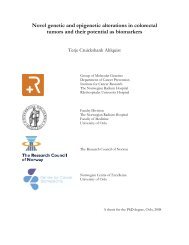Preface - Ous-research.no
Preface - Ous-research.no
Preface - Ous-research.no
Create successful ePaper yourself
Turn your PDF publications into a flip-book with our unique Google optimized e-Paper software.
Molecular Cardiology<br />
Leader:<br />
Håvard Attramadal Professor, MD, PhD (OUH/UiO)<br />
Scientific staff:<br />
M. Shakil Ahmed, Senior Scientist, PhD (OUH)<br />
Vladimir N. Marti<strong>no</strong>v, PhD, Postdoc (NRC)<br />
Thomas G. von Lueder, MD, Postdoc, (OUH)<br />
Jørgen A. Gravning, MD, PhD-student (OUH)<br />
Ingvild Tronstad Moe, MD, PhD-Student (NCCD/UiO)<br />
Tuyet Anh Pham, MD, PhD-student (SENRHA)<br />
Eva Maria Rehbinder, MD, PhD-student (NCCD)<br />
Fermí Montó Guillot, MSc, PhD-student/Exchange scientist<br />
(Valencia University School of Pharmacy)<br />
Else Marie Valbjørn Hagelin, MSc, Senior Engineer (SENRHA)<br />
Professor Håvard Attramadal<br />
Research Area<br />
Heart failure, the common end-point in cardiac disease of<br />
diverse etiologies, is a major cause of morbidity and mortality<br />
in affluent societies. Indeed, the incidence and prevalence<br />
of heart failure in these countries are increasing due<br />
to altered demographics with increased proportion of the<br />
elderly, as well as increased survival of myocardial infarction.<br />
Despite implementation of several new treatment modalities<br />
during the last 20 years, heart failure is still a progressive<br />
and omi<strong>no</strong>us disease indicating that important pathogenic<br />
mechanisms remain unmodified by the most current treatment<br />
modalities.<br />
In evolving heart failure multiple compensatory actions<br />
are triggered in order to maintain cardiac output, among<br />
which is activation of the sympathetic nervous system, the<br />
renin-angiotensin system, as well as a number of autocrine/<br />
paracrine factors synthesized in myocardial tissue. The<br />
compensatory actions also reflect alterations in of cardiac<br />
structure, collectively called cardiac remodeling. These<br />
structural alterations comprise dilatation of the ventricular<br />
chambers, myocardial hypertrophy and fibrosis. Although<br />
cardiac remodeling may initially balance loss of contractile<br />
force, the continuum of these structural alterations often<br />
feeds into vicious circles leading to progression of cardiac<br />
dysfunction and overt heart failure. Increasing evidence<br />
points to myocardial hypertrophy, fibrosis, and dilatation of<br />
the ventricular cavities as independent risk factors of heart<br />
failure. Indeed, recognition of these structural alterations<br />
of the heart is implemented in the new recommendations<br />
for the evaluation and management of chronic heart failure<br />
recently published by the American College of Cardiology/<br />
American Heart Association Task Force. According to these<br />
recommendations, which are meant to complement the<br />
New York Heart Association (NYHA) functional classification,<br />
patients are to be stratified according to risk factors for<br />
developing heart failure, including the absence or presence<br />
of structural alterations of the heart.<br />
Despite substantial new insights into the mechanisms of<br />
myocardial hypertrophy and fibrosis, many of the <strong>no</strong>dal<br />
points that orchestrate these structural alterations still<br />
remain to be identified. Furthermore, current k<strong>no</strong>wledge<br />
largely precludes from deciphering of adaptive versus maladaptive<br />
cellular responses to insufficient cardiac output.<br />
Thus, the focus of our <strong>research</strong> group is to unravel the signal<br />
transduction mechanisms leading to dysfunctional signaling<br />
responses and pathologic remodeling of the heart. The<br />
purpose of these investigations is to provide new k<strong>no</strong>wledge<br />
of disease mechanisms enabling development of <strong>no</strong>vel<br />
pharmacological interventions for heart failure.<br />
Our <strong>research</strong> group is a multidisciplinary team of experts<br />
in gene tech<strong>no</strong>logy, molecular and cellular biology, as well<br />
as experimental and clinical medicine. The <strong>research</strong> efforts<br />
comprise studies of isolated cardiac myocytes, integrated<br />
physiology in transgenic animal models, as well as clinical<br />
investigations. Our <strong>research</strong> group is member of Center for<br />
Heart Failure Research, University of Oslo (www.heartfailure.<br />
<strong>no</strong>), a thematic <strong>research</strong> initiative and focus area of <strong>research</strong><br />
selected by the Faculty of Medicine. Center for Heart Failure<br />
Research has also become a regional <strong>research</strong> network<br />
sponsored by Helse Sør-Øst Regional Health Authority. The<br />
Institute for Surgical Research provides infrastructure with<br />
state-of-the-art equipment for high-resolution echocardiography<br />
and integrated physiologic assessment of cardiac<br />
function in transgenic mice.<br />
15
















